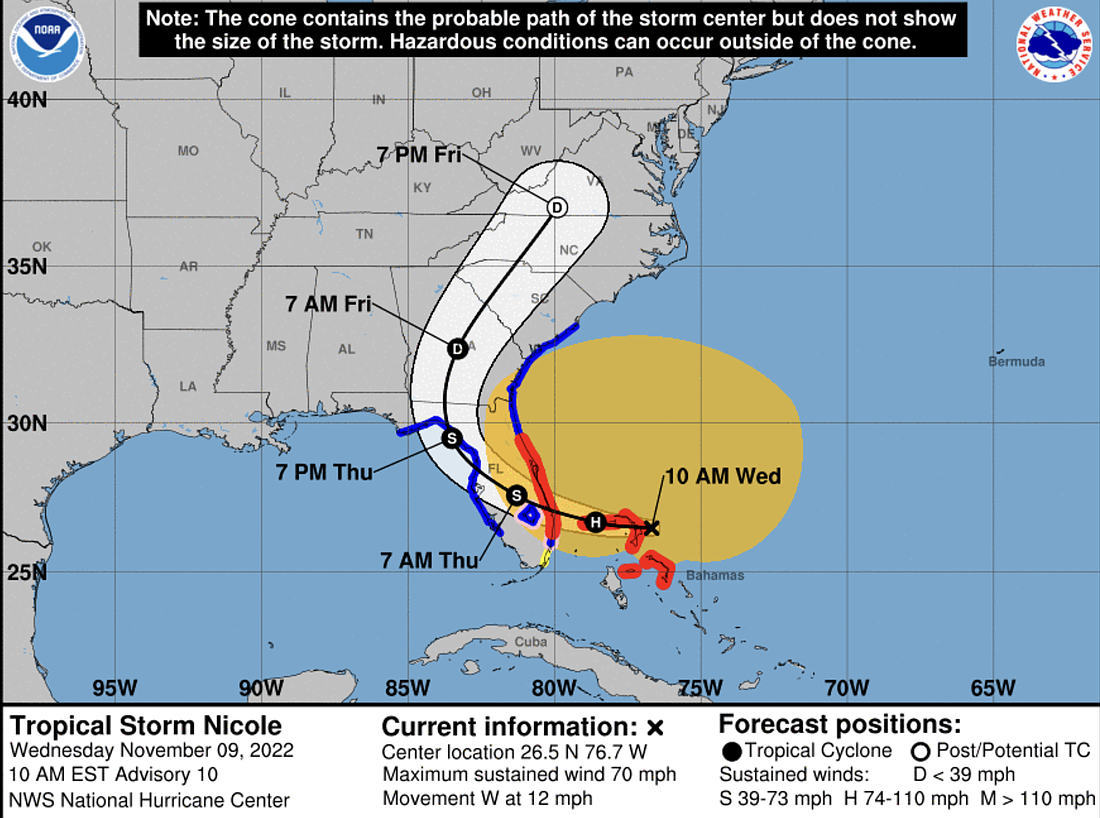- December 15, 2025

Tropical Storm Nicole, which is anticipated to be classified as a hurricane later today, is nearing the Florida peninsula, expecting to make landfall later this evening. Now is the time to make any final preparations and review pre-storm safety.
If you haven’t already done so, take a final look around your property. Be sure to secure items such as furniture, tools, flowerpots, wind chimes and yard debris. These items could become airborne in high winds and cause damage or injury.
Volusia County is already feeling the impacts as the storm approaches Florida’s east coast. Maximum impacts will be felt from 10 p.m. tonight, Nov. 9, through noon tomorrow Nov. 10.
Threat of tornado activity
Volusia County is under a hurricane warning for the coastal areas and a tropical storm warning inland. There will be a potential risk for tornado activity during the storm. It’s important for everyone to identify a safe room in their home where they can go during a tornado. This should be an interior room with no windows. Also, be sure to keep your weather radio on and take it to your safe room with you.
Mandatory evacuation
As a reminder, Volusia County has issued a mandatory evacuation order beginning at 10 a.m. today, Nov. 9, for all residences and businesses that are:
Evacuees are encouraged to stay with family, friends or an inland hotel and must complete their evacuation by 4 p.m. today, Nov. 9, because conditions will begin to deteriorate significantly.
Countywide curfew
A countywide curfew is in effect beginning 7 p.m. today, Nov. 9, through 7 a.m. tomorrow, Nov. 10.
Avoid unnecessary driving
Except for evacuations, residents are advised to shelter in place and stay off the roads until notified that it’s safe to go out. Standing water, downed trees and other debris could make roads dangerous and impassible. Not only that, but at some point during the storm, emergency crews may not be able to respond to calls.
Traffic signals
Some traffic signals may not be operating. If you approach an intersection that is not operable, you must treat it as a four-way stop.
Downed power lines and outages
If you see a downed line, assume that it’s electrified and don’t touch it or go near it. Report it to your power company as well as the Citizens Information Center at 866-345-0345.
To report power outages or downed power lines, contact your electric provider:
Food safety for power outages
According to the Centers for Disease Control, refrigerated or frozen foods may not be safe to eat after the loss of power.
Follow these tips during the power outage:
Follow these tips after power is restored:
Generator safety
Carbon monoxide (CO) is an invisible, odorless, tasteless gas and is highly poisonous. Depending on the level of exposure, CO may cause fatigue, weakness, chest pains for those with heart disease, shortness of breath upon exertion, nausea, vomiting, headaches, confusion, lack of coordination, impaired vision, loss of consciousness, and in severe cases, death.
If you lose power and plan to use a generator, follow these safety tips:
Hotel accommodations
Evacuees seeking accommodations on the mainland side of Volusia County can visit the following link: https://www.daytonabeach.com/places-to-stay/hotels/near-daytona-international-speedway/. In addition, Visit Florida has activated the Emergency Accommodations Module on Expedia.com to provide real-time hotel and lodging availability for impacted Floridians and visitors.
Closures
Volusia County offices and libraries will be closed Thursday and Friday. Additionally, the following offices and services will be closed Thursday and Friday: Florida Department of Health in Volusia County, Property Appraiser’s Office, Tax Collector’s Office and court facilities.
Daytona Beach International Airport will close at 12:30 p.m. Wednesday, Nov. 9, due to Tropical Storm Nicole. All flights after this time are canceled, with the exception of government, emergency and humanitarian aircraft. The airport is scheduled to reopen at 4 a.m. Friday, Nov. 11. Passengers should check with their airlines for updates to flight schedules.